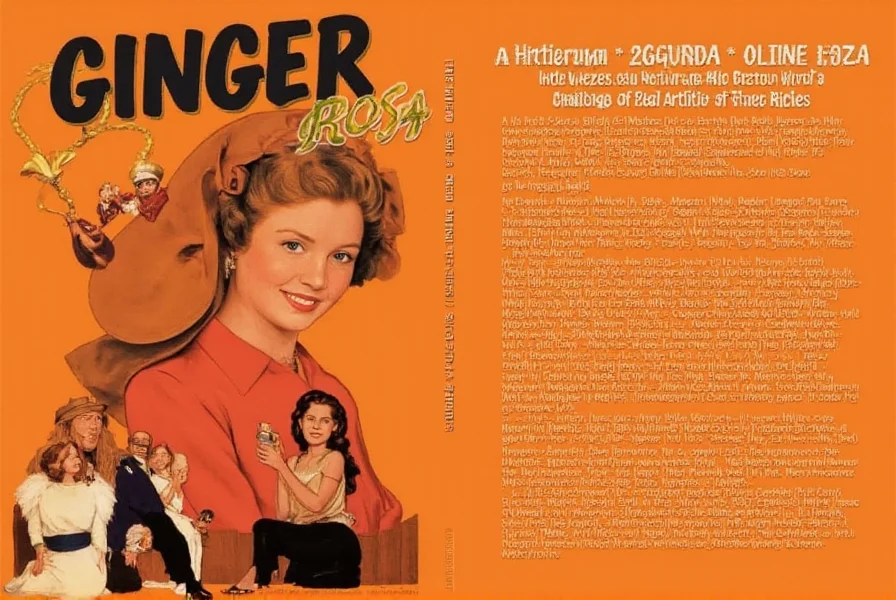The phrase "ginger & rosa" most commonly refers to Sally Potter's critically acclaimed 2012 film that captures a pivotal moment in adolescent development against a historically significant political backdrop. This cinematic work stands as a powerful exploration of female friendship during a time of global uncertainty, offering viewers a window into the emotional landscape of teenage girls in 1962 London.
Understanding the Film's Historical Context
When examining ginger and rosa film analysis, the historical setting proves crucial to understanding the narrative's tension. The Cuban Missile Crisis of October 1962 serves as more than just a backdrop—it actively shapes the characters' experiences and anxieties. As world leaders debated nuclear war, teenagers like Ginger and Rosa processed these existential threats while simultaneously navigating their own personal crises.
The film's authenticity stems from Potter's meticulous attention to period detail, from the fashion and music to the political activism that permeated London society. This historical accuracy supports what many consider one of the most compelling aspects of the ginger & rosa 1960s setting—its ability to parallel global and personal coming-of-age experiences.
| Key Film Details | Information |
|---|---|
| Release Year | 2012 |
| Director | Sally Potter |
| Main Cast | Elle Fanning (Ginger), Alice Englert (Rosa) |
| Setting | London, 1962 (Cuban Missile Crisis) |
| Runtime | 93 minutes |
Character Dynamics and Thematic Depth
The heart of ginger and rosa character dynamics lies in the complex relationship between the two protagonists. Ginger represents intellectual curiosity and political awareness, while Rosa embodies emotional intensity and rebellion. Their friendship evolves through shared experiences that test boundaries and challenge their understanding of loyalty, identity, and growing up.
What makes this ginger and rosa coming of age story particularly resonant is how it intertwines personal and political awakenings. As the girls confront family secrets and societal expectations, they simultaneously process the very real possibility of nuclear annihilation. This dual perspective creates a rich narrative texture that elevates the film beyond a simple teenage drama.
Artistic Approach and Production Insights
Sally Potter's directorial choices significantly contribute to the film's distinctive atmosphere. The decision to shoot in black and white with selective color elements creates a visual metaphor for the girls' evolving perspectives—some aspects of their world remain starkly defined while others gradually gain nuance and complexity.
The production design meticulously recreates 1960s London, from the interior of Ginger's activist parents' home to the streets filled with anti-nuclear protest signs. This attention to detail supports the sally potter ginger and rosa vision of a world where personal and political spheres constantly intersect.
Cultural Significance and Critical Reception
Since its release, ginger and rosa historical context has gained recognition as a significant contribution to coming-of-age cinema, particularly for its nuanced portrayal of female adolescence. Critics praised the film's authentic dialogue, strong performances (especially from the young leads), and its ability to balance intimate character study with broader historical significance.
The film's exploration of how global events shape personal development continues to resonate with contemporary audiences, making it relevant beyond its specific historical moment. This enduring quality explains why ginger and rosa film analysis remains a subject of academic and critical discussion years after its initial release.
Why This Story Continues to Matter
In today's world of ongoing geopolitical tensions and youth activism, the themes explored in Ginger & Rosa feel remarkably current. The film demonstrates how young people process large-scale crises while simultaneously navigating the universal challenges of adolescence. This dual perspective offers valuable insights for understanding how historical context shapes individual development.
For educators and film enthusiasts seeking meaningful coming-of-age stories with historical depth, ginger and rosa 1960s setting provides rich material for discussion about political awareness, female friendship, and the intersection of personal and global histories.
What is the main theme of Ginger & Rosa?
The primary theme explores how global political crises intersect with personal coming-of-age experiences. The film examines how the Cuban Missile Crisis of 1962 affects two teenage girls' friendship, identity formation, and understanding of the world around them, showing how historical events shape personal development.
Is Ginger & Rosa based on a true story?
No, Ginger & Rosa is not based on a specific true story, though director Sally Potter drew from her own experiences growing up in 1960s London during the Cuban Missile Crisis. The film blends historical accuracy with fictional narrative to explore universal themes of adolescence against a specific historical backdrop.
What age group is appropriate for watching Ginger & Rosa?
The film is rated PG-13 for mature thematic elements and brief language. It's generally appropriate for viewers aged 13 and older, particularly those interested in historical dramas and coming-of-age stories. The film's exploration of complex emotional and political themes makes it especially valuable for high school students studying 20th century history or literature.
How does the Cuban Missile Crisis feature in Ginger & Rosa?
The Cuban Missile Crisis serves as the film's central historical backdrop, creating constant tension that mirrors the protagonists' personal crises. News broadcasts, protest activities, and family discussions about nuclear war permeate the girls' daily lives, directly influencing their emotional states and decision-making throughout the story.
What makes Ginger & Rosa stand out among coming-of-age films?
Ginger & Rosa distinguishes itself through its precise historical setting during the Cuban Missile Crisis, its focus on female friendship rather than romance, and its sophisticated exploration of how global political events shape adolescent development. The film avoids typical coming-of-age tropes by emphasizing intellectual and political awakening alongside emotional growth.











 浙公网安备
33010002000092号
浙公网安备
33010002000092号 浙B2-20120091-4
浙B2-20120091-4